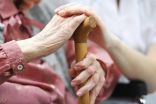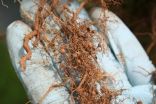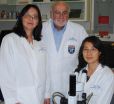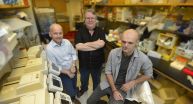Insomnia among older adults may be tied to sleep quality, not duration
2014-10-08
Reports of insomnia are common among the elderly, but a new study finds that sleep problems may stem from the quality of rest and other health concerns more than the overall amount of sleep that patients get.
An estimated 30 percent of adults report having some symptoms of insomnia, which includes difficulty falling asleep, staying asleep or waking up too early and then not feeling well rested during the daytime. Prior studies suggest that nearly half of older adults report at least one insomnia symptom and that lack of restorative sleep might be linked to heart disease, ...
Wildlife refuge plans show strengths and weaknesses for adaptation to climate change
2014-10-08
As the effects of a changing climate become acute, organizations charged with overseeing refuge areas must take action to adapt. The US Fish and Wildlife Service (USFWS) maintains the National Wildlife Refuge System, which constitutes world's largest system of protected lands and waters. According to a November BioScience article by Robert Fischman and Vicky Meretsky of Indiana University and their coauthors, the service may not always be adequately planning for an altered future, but best practices from several plans point the way for improvement. For instance, existing ...
New weapons against multidrug resistance in tuberculosis
2014-10-08
Using a high-throughput screening assay, EPFL scientists have discovered two small molecules that could overcome the multidrug resistance of the bacterium that causes tuberculosis.
Tuberculosis is an infectious disease caused by a bacterium called Mycobacterium tuberculosis (Mtb), which commonly infects the lungs. In 2012, the World Health Organization estimated that tuberculosis affected 8.6 million people worldwide, causing death in 1.4 million. However, the fight against the disease is hampered by the fact that treatment requires a long time and that Mtb often develops ...
Nursing home infection rates on the rise, study finds
2014-10-08
(NEW YORK, NY, Oct. 8, 2014) – Nursing home infection rates are on the rise, a study from Columbia University School of Nursing found, suggesting that more must be done to protect residents of these facilities from preventable complications. The study, which examined infections in U.S. nursing homes over a five-year period, found increased infection rates for pneumonia, urinary tract infections (UTIs), viral hepatitis, septicemia, wound infections, and multiple drug-resistant organisms (MDROs).
"Infections are a leading cause of deaths and complications for nursing ...
Invasive plant wins competition against its native cousin
2014-10-08
URBANA, Ill. – Because of its aggressive behavior and its harmful effects, the invasive prairie plant Lespedeza cuneata has been added to several noxious weed lists.
Research at the University of Illinois on how soil bacteria interact with the plants' roots to form nodules that fix nitrogen demonstrated that the invasive variety had superior performance when pitted against the native plant variety Lespedeza virginica.
"We expected Lespedeza cuneata to be a strong competitor when up against its native cousin that's planted primarily for prairie restoration," ...
MU researchers identify epigenetic changes caused by binge drinking
2014-10-08
COLUMBIA, Mo. — Researchers at the University of Missouri School of Medicine have identified epigenetic protein changes caused by binge drinking, a discovery that could lead to treatments for alcohol-related liver diseases.
"We know that chronic alcohol use is damaging to the liver, but binge drinking amplifies that damage," said Shivendra Shukla, Ph.D., Margaret Proctor Mulligan Professor at the MU School of Medicine and lead author of the study.
Excessive alcohol use is one of the most common causes of chronic liver failure. Long-term liver damage from alcohol ...
Smartphone understands hand gestures
2014-10-08
This news release is available in German. It does seem slightly odd at first: you hold the phone in one hand, and move the other in the air above its built-in camera making gestures that resemble sign language. Sometimes you move your index finger to the left, sometimes to the right. You can spread out your fingers, or imitate a pair of pliers or the firing of a pistol. These gestures are not, however, intended for communicating with deaf people; they are for controlling your smartphone.
By mimicking the firing of a pistol, for example, a user can switch to another ...
NASA sees Simon spreading over US Southwest
2014-10-08
The remnants of Hurricane Simon were fanning out over the desert Southwestern U.S. on Oct. 8 and NASA's Aqua satellite captured infrared data on the thunderstorms expected to bring flash flooding.
NOAA's National Weather Service (NWS) indicated on Oct. 8, that Simon's remnants would be bringing heavy rain and the possibility of flash flooding to the desert Southwest. NWS noted "Moisture associated with the remnants of Tropical Storm Simon will bring showers and isolated thunderstorms to parts of the Desert Southwest on Wednesday. Rainfall totals of up to an inch or more ...
Study: Indian government health insurance reduced mortality among the poor
2014-10-08
A government program to provide health insurance for catastrophic illness to households below the poverty line in Karnataka, lowered both mortality rates and out-of-pocket expenses for the residents, according to a recent evaluation published in the leading global health journal The BMJ.
The program is implemented by the Karnataka government with support from the World Bank Group.
An evaluation of the program, the Vajpayee Arogyashree Scheme (VAS), funded by the World Bank Group and led by Neeraj Sood, professor and director of research at the USC Schaeffer Center for ...
Media celebrate female NFL referee, but fumble deeper issues
2014-10-08
The sports media's positive reaction to the hiring of a female referee in professional football is a good sign, according to a Penn State researcher, but did little to help expose deeper issues that hinder greater acceptance of women in sports.
In a study of online stories and posts about the hiring of Shannon Eastin as an NFL official during the 2012 referee's union strike, Dunja Antunovic, a doctoral candidate in mass communications, said that the media mostly celebrated her NFL debut.
"It was generally positive," said Antunovic. "However, it might be a mistake to ...
Study finds potential link between breast cancer genes and salivary gland cancer
2014-10-08
COLUMBUS, Ohio – The risk of developing cancer in a salivary gland might be higher in people with mutations in either of two genes associated with breast and ovarian cancer, according to a new study by researchers at The Ohio State University Comprehensive Cancer Center – Arthur G. James Cancer Hospital and Richard J. Solove Research Institute (OSUCCC – James).
Although salivary gland cancer is rare, this retrospective study suggests it occurs 17 times more often in people with inherited mutations in genes called BRCA1 and BRCA2, than those in the general ...
Neuroscientists use snail research to help explain 'chemo brain'
2014-10-08
It is estimated that as many as half of patients taking cancer drugs experience a decrease in mental sharpness. While there have been many theories, what causes "chemo brain" has eluded scientists.
In an effort to solve this mystery, neuroscientists at The University of Texas Health Science Center at Houston (UTHealth) conducted an experiment in an animal memory model and their results point to a possible explanation. Findings appeared in The Journal of Neuroscience.
In the study involving a sea snail that shares many of the same memory mechanisms as humans and a drug ...
Mangroves protecting corals from climate change
2014-10-08
Certain types of corals, invertebrates of the sea that have been on Earth for millions of years, appear to have found a way to survive some of their most destructive threats by attaching to and growing under mangrove roots.
Scientists with the U.S. Geological Survey and Eckerd College recently published research on a newly discovered refuge for reef-building corals in mangrove habitats of the U.S. Virgin Islands. More than 30 species of reef corals were found growing in Hurricane Hole, a mangrove habitat within the Virgin Islands Coral Reef National Monument in St. John.
Corals ...
Study: Talking while driving safest with someone who can see what you see
2014-10-08
CHAMPAIGN, Ill. — A new study offers fresh insights into how talking on a cell phone or to a passenger while driving affects one's performance behind the wheel. The study used a driving simulator and videophone to assess how a driver's conversation partner influences safety on the road.
"We've done years of study on driver distraction, and previous studies suggest that passengers often aren't distracting. In fact, passengers can be helpful, especially if they're adults who have had experience and also are active drivers themselves," said University of Illinois psychology ...
Country's economy plays role in Internet file-sharing patterns
2014-10-08
Peer-to-peer file sharing of movies, television shows, music, books and other files over the Internet has grown rapidly worldwide as an alternative approach for people to get the digital content they want -- often illicitly. But, unlike the users of Amazon, Netflix and other commercial providers, little is known about users of peer-to-peer (P2P) systems because data is lacking.
Now, armed with an unprecedented amount of data on users of BitTorrent, a popular file-sharing system, a Northwestern University research team has discovered two interesting behavior patterns: ...
In a battle of brains, bigger isn't always better
2014-10-08
Cold Spring Harbor, NY – It's one of those ideas that seems to make perfect sense: the bigger the brain, the more intelligent the creature. While it is generally true, exceptions are becoming increasingly common. Yet the belief persists even among scientists. Most biologists, for example, assume that rats, with larger brains, are smarter than mice. Cold Spring Harbor Laboratory (CSHL) scientists now challenge this belief. They compared mice and rats and found very similar levels of intelligence, a result that could have powerful implications for researchers studying ...
Childhood psychological abuse as harmful as sexual or physical abuse
2014-10-08
WASHINGTON - Children who are emotionally abused and neglected face similar and sometimes worse mental health problems as children who are physically or sexually abused, yet psychological abuse is rarely addressed in prevention programs or in treating victims, according to a new study published by the American Psychological Association.
"Given the prevalence of childhood psychological abuse and the severity of harm to young victims, it should be at the forefront of mental health and social service training," said study lead author Joseph Spinazzola, PhD, of The Trauma ...
Scientists question fundamental theory about education of immune police
2014-10-08
AUGUSTA, Ga. – A fundamental theory about how our thymus educates our immune police appears to be wrong, scientists say.
It's known that stem cells come out of the bone marrow and travel to the tiny thymus gland behind the breastbone to learn to become one of two CD4T cell types: one leads an attack, the other keeps the peace.
One widely held concept of why they become one or the other is that, despite coming from the same neighborhood and going to the same school, they are exposed to different things in the thymus, said Dr. Leszek Ignatowicz, immunologist at ...
Timely Ebola information from Journal of Disaster Medicine & Public Health Preparedness
2014-10-08
Rockville, MD – The Society for Disaster Medicine and Public Health is committed to examining the details of individual disasters and public health crises. With the recent arrival of Ebola in the United States, the journal is launching a special issue on the virus. The journal will serve as an educated and authoritative voice on the virus, risk and threat level, potential of outbreak, preparation and response for the public and media.
The Journal of Disaster Medicine and Public Health Preparedness, began covering events in their entirety via special issues this ...
Robotic surgery: More complications, higher expense for some conditions
2014-10-08
NEW YORK, NY (October 8, 2014)—For benign gynecologic conditions, robot-assisted surgery involves more complications during surgery and may be significantly more expensive than conventional laparoscopic surgery, according to a study by researchers at Columbia University Medical Center (CUMC). The results were published online today in Obstetrics & Gynecology.
Robot-assisted surgery was first widely used for radical prostatectomy. For procedures such as prostatectomy, where there were previously no minimally invasive options, robot-assisted laparoscopy often offered ...
Trying to fool a kindergartner? Not so fast
2014-10-08
This news release is available in French. Montreal & Vancouver, October 8, 2014 — From the words for colours to how to tie a shoelace, kids have lots to learn — and for the most part, they depend on others to teach it to them.
But whether deliberately or inadvertently, other people sometimes misinform. So at what age can kids tell trustworthy teachers from confident tricksters?
A new study published in PLOS ONE by psychology researchers from Concordia University and the University of British Columbia shows that by the age of five, children become wary ...
Managers can boost creativity by 'empowering leadership' and earning employees' trust
2014-10-08
HOUSTON – (Oct. 8, 2014) – Managers can promote creativity in employees by "empowering leadership" and earning employees' trust, according to a new study by Rice University and American University.
The researchers investigated, for the first time, the complex effect of the interaction among empowering leadership, uncertainty avoidance and trust on creativity. They collected supervisors' ratings of employee creativity in two separate studies in China: one with employees of an energy-saving light bulb design and manufacturing company and the other with the employees ...
Gay and bisexual youth can thrive with positive family relationships
2014-10-08
Gay and bisexual youth who are supported by their family and feel comfortable talking to them about their lifestyle are less likely to become involved in high-risk sexual behaviors, according to a recent Rutgers study.
Published in the Journal of Marital & Family Therapy, the Rutgers School of Social Work study, Condoms and connection: Parents, gay and lesbian youth and HIV risk, found that positive family relationships and open dialogue led to an increase in safe sex practices, including the use of condoms, while disrupted family relationships resulted in risky sexual ...
Drug regimen enough to control immune disease after some bone marrow transplants
2014-10-08
Johns Hopkins and other cancer researchers report that a very short course of a chemotherapy drug, called cyclophosphamide, not only can prevent a life-threatening immune response in some bone marrow transplant recipients, but also can eliminate such patients' need for the usual six months of immune suppression medicines commonly prescribed to prevent severe forms of this immune response. Patients receive cyclophosphamide for two days after their bone marrow transplant, in addition to two other chemotherapy drugs given before the transplant.
Johns Hopkins Kimmel Cancer ...
Slime-producing molecules help spread disease from cats to sea otters
2014-10-08
The spread of diseases from land animals to sea otters and other marine mammals is aided and abetted by gelatinous, sticky polymers produced by seaweed, reports a research team headed by a UC Davis veterinary infectious-disease expert.
These large, complex molecules form slimy biofilms and bind water-borne organic matter into larger particles, in which disease-causing microorganisms can become embedded and introduced to the marine food chain, the researchers discovered.
Using the parasite Toxoplasma gondii as a model, they showed how these sticky polymers increase the ...
[1] ... [3158]
[3159]
[3160]
[3161]
[3162]
[3163]
[3164]
[3165]
3166
[3167]
[3168]
[3169]
[3170]
[3171]
[3172]
[3173]
[3174]
... [8701]
Press-News.org - Free Press Release Distribution service.







